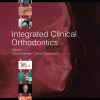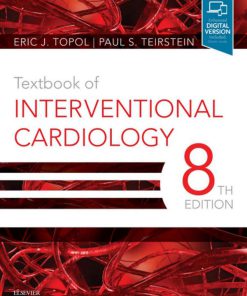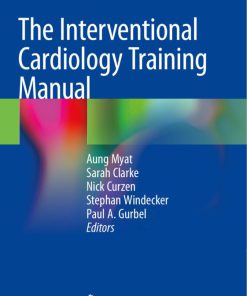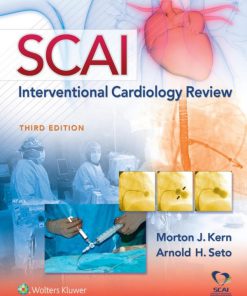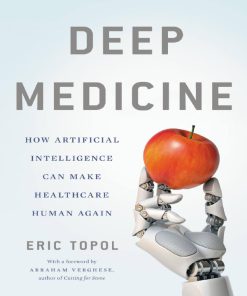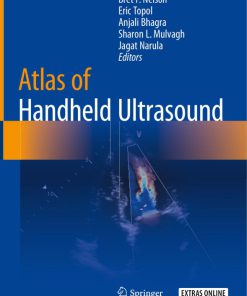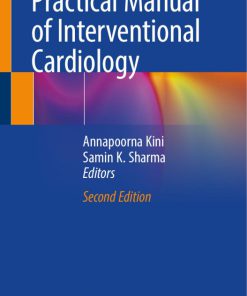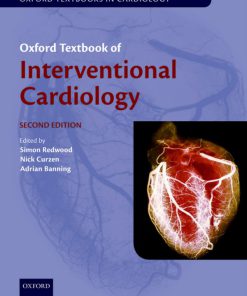Textbook of Interventional Cardiology 8th Edition by Eric Topol, Paul Teirstein ISBN 0323568130 9780323568135
$50.00 Original price was: $50.00.$25.00Current price is: $25.00.
Authors:Textbook of Interventional Cardiology-Elsevier Inc. (2019) , Author sort:Textbook of Interventional Cardiology-Elsevier Inc. (2019) , Published:Published:Sep 2019
Textbook of Interventional Cardiology 8th Edition by Eric Topol, Paul Teirstein – Ebook PDF Instant Download/Delivery. 0323568130, 9780323568135
Full download Textbook of Interventional Cardiology 8th Edition after payment

Product details:
ISBN 10: 0323568130
ISBN 13: 9780323568135
Author: Eric Topol, Paul Teirstein
From new research and equipment to new procedures, applications, and approaches, the field of interventional cardiology is one of the fastest-changing areas in medicine. Increasing data and recent technological advances have resulted in exciting changes – and an even greater need for cutting-edge, authoritative guidance on current practice. Textbook of Interventional Cardiology, 8th Edition, covers the theories, trends, and applications of diagnostic and interventional cardiology that cardiologists, cardiac surgeons, vascular surgeons, referring physicians, and advanced practitioners need to know.
Textbook of Interventional Cardiology 8th Table of contents:
SECTION I. Patient Selection
1. Individualized Assessment for Percutaneous or Surgical-Based Revascularization
Need for Individualized Patient Assessment
Technologic Advances
Historic (Pre-Syntax) Clinical Trial Results
Individual Assessment from A Physician’s Perspective
SYNTAX-Based Clinical Tools
Individual Assessment from a Patient’s Perspective
Conclusions
2. Evidence-Based Interventional Practice
Overview
Prognostic Indications for Myocardial Revascularization
Prognostic Indication for Revascularization: Percutanous Coronary Intervention Versus Coronary Artery Bypass Grafting
Percutaneous Coronary Intervention Versus Medical Therapy Alone
Summary
3. Diabetes
Pathophysiology of Atherosclerosis in Diabetes
Cardiovascular Disease in Diabetes
Myocardial Ischemia Detection in Diabetic Patients
Revascularization Versus Medical Management
Diabetes and Non–ST-Elevation Acute Coronary Syndromes
Early Invasive Versus Conservative Strategy
Diabetes and ST-Elevation Myocardial Infarction
Glucose-Lowering Therapy in the Acute Phase of Acute Coronary Syndromes
Aspirin and Clopidogrel
Prasugrel and Ticagrelor
Glycoprotein IIb/IIIa Receptor Antagonists and Anticoagulants
Long-Term Diabetes Management
Multifactorial Intervention
4. Noninvasive Evaluation: Functional Testing, Multidetector Computed Tomography, and Stress Cardiac MRI
Stress Testing
Contrast Perfusion Imaging
Cardiac Magnetic Resonance Imaging
Myocardial Viability Assessment
Hybrid Imaging
Appropriate Use Criteria
Radiation Exposure Relative Health Risks
Conclusions
5. Intracoronary Pressure and Flow Measurements
Fundamental Concepts of Coronary Blood Flow
Methodology of Coronary Pressure Measurement
Clinical Outcomes with Fractional Flow Reserve–Guided Percutaneous Coronary Intervention
Conclusion
6. Contrast-Induced Acute Kidney Injury and the Role of Chronic Kidney Disease in Percutaneous Coronary Intervention
Introduction
Definition of Contrast-Induced Acute Kidney Injury
Pathophysiology
Epidemiology and Risk Factors for Contrast-Induced Acute Kidney Injury
Predicting the Risk of Contrast-Induced Acute Kidney Injury
Prognosis of Contrast-Induced Acute Kidney Injury
Chronic Kidney Disease
Prevention Strategies to Minimize the Risk of Contrast-Induced Acute Kidney Injury
Transcatheter Aortic Valve Replacement Population
Critical View and Future Demands
7. Radiation Safety During Cardiovascular Procedures
Introduction
Radiation Risk
Radiation Management
Fluoroscopic Imaging Equipment
Patient Radiation Dose Management
Staff Radiation Protection
8. Coronary and Valvular Intervention Prior to Noncardiac Surgery
Introduction
Perioperative Myocardial Infarction
Indications for Preoperative Coronary Angiography
Pharmacologic Therapy for Noncardiac Surgery
Preoperative Percutaneous Coronary Intervention
Unanticipated Surgery After Stenting
Summary and Recommendations
Investigational Strategies
Novel Drug-Eluting Stent Platforms
9. Sex and Ethnicity Issues in Interventional Cardiology
Overview
Sex
Vascular Complications
Sex Differences in Adjunctive Pharmacotherapy
Sex Differences in Structural Interventional Procedures
Sex Differences in Peripheral Interventional Procedures
Race and Ethnicity
Conclusion
SECTION II. Pharmacologic Intervention
10. Platelet Inhibitor Agents
Basic principles of antiplatelet therapy
Aspirin
P2Y12 Inhibitors
Conclusion
11. Anticoagulation in Percutaneous Coronary Intervention
Introduction
The Biology of Atherothrombosis
Adverse Events Following Percutaneous Coronary Intervention
Pharmacology of Anticoagulant Agents Used in Current ERA Percutaneous Coronary Intervention
New Pharmacologic Targets
Anticoagulant Therapy in STEMI, NSTEACS, and Elective Percutaneous Coronary Intervention
Summary
Special Patient Groups
Conclusion
12. Thrombolytic Intervention
Introduction
Thrombolytic Agents
Major Historical Comparative Thrombolytic Trials
Timing of Thrombolytic Therapy
Adjunctive Therapies
Facilitated Percutaneous Coronary Intervention
Pharmacoinvasive Strategy
International Perspective
Summary
13. Other Adjunctive Drugs for Coronary Intervention: Beta-Blockers, Calcium-Channel Blockers, and Angiotensin-Converting Enzyme Inhibitors
Introduction
β-Adrenergic Receptors
Calcium Channels
Conclusion
SECTION III. Coronary Intervention
14. Coronary Stenting: Practical Considerations, Equipment Selection, Tips and Caveats
Introduction
Access Site Selection
Guide Catheter Selection
Guide Extensions
Coronary Guidewire Selection
Coronary Microcatheters and Over the Wire Balloons
Stent Selection
Facilitated Stent Delivery
Coronary Atherectomy
Contrast and Radiation Sparing
Management of Complications
Conclusion
15. Coronary Stenting
introduction
Bare-Metal Stent Overview
Drug-Eluting Stents Overview
Safety and Efficacy of Drug-Eluting Stents and Bare-Metal Stents: Synthesizing the Data Through Meta-Analyses
Polymer-Free Drug-Eluting Stents
Stents in Specific Situations
Stent Failure Mechanisms and Management
Conclusions and Future Directions
16. Bioresorbable Coronary Scaffolds
Introduction
Terminology: Stents, Scaffolds, Biodegradation, Bioabsorption and Bioresorption
Rationale and Promises of Bioresorbable Scaffold
Historic Development
Materials and Properties
Current Landscape of Clinically Tested Bioresorbable Scaffold
From Initial Trials and Promises to Current Status and Future Outlook
17. Drug-Eluting Balloons
Introduction
Preclinical Data
Clinical Data on Drug-Coated Balloons
The Future of Drug-Coated-Balloon Technology
Summary
18. Elective Intervention for Stable Angina or Silent Ischemia
Introduction
Revascularization in Patients With Chronic Stable Angina
Selection of Revascularization Strategy
Summary
19. Intervention for Non–ST-Segment Elevation Acute Coronary Syndromes
Overview
Risk Stratification
Approach to Revascularization
Adjunctive Antithrombotic Therapies in NSTE-ACS
Radial VERSUS Femoral Approach
Considerations in Patients with Nste-Acs and Complex Coronary Disease
Culprit-Vessel Versus Multivessel Percutaneous Coronary Intervention
Single-Sitting Versus Staged Multivessel Percutaneous Coronary Intervention
20. Percutaneous Coronary Intervention in Acute ST-Segment Elevation Myocardial Infarction
Introduction
General Aspects
Time-To-Reperfusion and Outcome of Primary Percutaneous Coronary Intervention
Door-To-Balloon Time and Outcome of Primary Percutaneous Coronary Intervention
Network Systems Optimizing Reperfusion in Patients with St-Elevation Myocardial Infarction
Primary Percutaneous Coronary Intervention in Late Presenters
Interhospital Transfer for Primary Percutaneous Coronary Intervention
Facilitated Percutaneous Coronary Intervention
Routine Use of Percutaneous Coronary Intervention After Fibrinolysis – Pharmacoinvasive Strategy
Rescue Percutaneous Coronary Intervention
Technical Aspects and Mechanical Strategies to Enhance Myocardial Salvage During Primary Percutaneous Coronary Intervention in St-Elevation Myocardial Infarction
Primary Stenting
Radial Artery Versus Femoral Artery Vascular Access for Primary Percutaneous Coronary Intervention
Multivessel Intervention in Patients with St-Segment Elevation Myocardial Infarction
Distal Protection Devices in Primary Percutaneous Coronary Intervention
Mechanical and Aspiration Thrombectomy
Deferred Stenting
Mechanical Circulatory Support Devices During Primary Percutaneous Coronary Intervention
Antithrombotic Therapy in Patients with St-Elevation Myocardial Infarction Undergoing Primary Percutaneous Coronary Intervention
Anticoagulant Therapy in Patients with St-Elevation Myocardial Infarction Undergoing Primary Percutaneous Coronary Intervention
Glycoprotein IIB/IIIA Inhibitors
Therapies to Reduce Microvascular Obstruction, Reperfusion Injury, and Infarct Size
Cell-Based Therapy and Regenerative Agents After St-Elevation Myocardial Infarction
Special Issues in Primary Percutaneous Coronary Intervention
Conclusion
21. Post-Percutaneous Coronary Intervention Hospitalization, Length of Stay, and Discharge Planning
Introduction
Post-Percutaneous Coronary Intervention Discharge Planning
The Role of Post-Percutaneous Coronary Intervention Monitoring of Cardiac Biomarkers, Platelet Inhibition, and Renal Function
Trends in PostProcedure Length of Stay
Same-Day Discharge Following Percutaneous Coronary Intervention
Conclusions
22. Interventions in Cardiogenic Shock
Background
Pathophysiology
Clinical Presentation
Treatment
Multivessel Disease
Long-Term Survival and Quality of Life
Conclusion
23. Bifurcations and Branch Vessel Stenting
Bifurcation Lesions
Two Stents as Intention-to-Treat
Two-Stent Techniques
Role of Adjunctive Procedures
Conclusions
24. Percutaneous Coronary Intervention for Unprotected Left Main Coronary Artery Stenosis
introduction
Anatomy and Pathology
Stenting Techniques
Stent Thrombosis and Antiplatelet Therapy after Drug-Eluting Stent Implantation
Current Status of Left Main Coronary Artery Percutaneous Coronary Intervention and Selection of Revascularization Strategy
Conclusions
25. Complex and Multivessel Percutaneous Coronary Intervention
Introduction
Multivessel Disease: Prevalence and Prognostic Implications
Revascularization in Patients with Multivessel Disease: Strategies, Landmark Studies, and Outcomes
Strategies to Improve Outcomes after Percutaneous Coronary Intervention for Multivessel Disease
Managing Multivessel Disease in Patients with Stemi
Conclusions
26. Intervention for Coronary Chronic Total Occlusions
Chronic Total Coronary Occlusion
Definition
Prevalence
pathology
Clinical Profile and Presentation
Indications for Revascularization
Ischemia and Left Ventricle Function
Collateral Circulation
Preparation for Chronic Total Occlusion Percutaneous Coronary Intervention
Approaches and Techniques
Structured Algorithms for Chronic Total Occlusion Percutaneous Coronary Intervention
Clinical Outcomes
Conclusion
27. Bypass Graft Intervention
The Scope of the Problem
Indications for Intervention
Technical Strategy
Results of Intervention
Complications
The Future of Bypass Graft Intervention
28. The Thrombus-Containing Lesion
Introduction
Processes of Thrombus Formation: Histopathology and Types
Thrombus Architecture and Related Characteristics
Detection of Thrombus-Containing Lesions
The Grading and Classification of Thrombi
Targeted Thrombus Revascularization Strategies
Pharmacotherapy
Mechanical Thrombus Removal
Stents for Targeted Thrombus Capture
Specific Thrombotic Lesions: Location, Effects, and Management Options
Left Main Coronary Lesions
Multivessel Coronary Thrombosis
Multiple Thrombi in a Single Vessel
Chronic Thrombotic Occlusion
Saphenous Vein Graft
Summary
29. Complications of Percutaneous Coronary Intervention
Introduction
Abrupt Closure
Coronary Perforation
Embolization of Percutaneous Coronary Intervention Equipment
Emergency Coronary Bypass Surgery
Coronary No-Reflow
Radiocontrast Hypersensitivity
Bleeding
Conclusion
30. Periprocedural Myocardial Infarction and Embolism-Protection Devices
Periprocedural Myocardial Infarction
Embolism Protection Devices
Definition
Incidence
Underlying Pathophysiologic Mechanisms
Risk Factors Predisposing to Periprocedural Myocardial Infarction
Prognostic Implications of Periprocedural Myocardial Infarction
Prevention and Management of Periprocedural Myocardial Infarction
Conclusions
Embolic Protection Devices
Saphenous Vein Graft Percutaneous Coronary Intervention
Conclusions
31. Access Management and Closure Devices
Introduction
Planning Access
Retrograde Puncture Technique for the Femoral Artery
Antegrade Puncture Technique for the Femoral Artery
Puncture Technique for the Brachial Artery
Puncture Technique for the Popliteal Artery
Transapical Left Ventricular Puncture
Hemostatic Methods After Percutaneous Cardiovascular Procedures
Access-Site Complications
Conclusions and Future Trends
32. Transradial Access for Cardiovascular Catheterization and Intervention
introduction
Rationale for Transradial Approach to Percutaneous Coronary Intervention
Feasibility and Security
Transradial Versus Transfemoral Approach for Percutaneous Coronary Intervention
Transradial Approach in St-Elevation Myocardial Infarction
Transradial Versus Transbrachial Approaches
Transradial Versus Transulnar Approach
Cost-Effectiveness
Practical Considerations for a Transradial Approach
33. Role of the Cardiac Surgeon and the Heart Team
Introduction
Role of The Surgeon on Surgical Standby
Transcatheter and Hybrid Cardiovascular Procedures
Transcatheter Aortic Valve Replacement
Hybrid Cardiac Surgeon
34. Restenosis
Introduction
Arterial Injury and Mechanisms of Restenosis
Angiographic and Clinical Features of Restenosis
Prevention of Restenosis–Drug-Eluting Stent Evolution and Redesigns
Treatment of Restenosis
Summary
35. Role of Adjunct Devices: Atherectomy, Cutting Balloon, and Laser
Introduction
Historical Background
Percutaneous Transluminal Rotational Atherectomy
Orbital Atherectomy
Directional Coronary Atherectomy
Cutting Balloon Angioplasty
Scoring Balloon Angioplasty
Laser Angioplasty
36. Supported Percutaneous Intervention
Introduction and Rationale: Identifying the high-risk Patient
Approach to the Patient
Description of Devices and Available Clinical Data
conclusions
37. Regional Centers of Excellence for the Care of Patients With Acute Ischemic Heart Disease
Intoduction
The Case for Regionalized Care
Percutaneous Coronary Intervention Centers without on-Site Cardiac Surgery
Benefits of Catheter-Based Therapy for Acute Coronary Syndromes
Non–St-Segment Elevation Acute Coronary Syndromes
Regionalization of Care for Cardiogenic Shock
Limited Medical Resources
38. Diagnosis and Treatment of Coronary Microvascular Disease
Introduction
Interpretation of the Test Results
Conclusions
SECTION IV. Peripheral Vascular Interventions
39. Lower Extremity Interventions
Epidemiology and Natural History
Vascular Anatomy of the Lower Extremity
Diagnosis of Lower Extremity Peripheral Arterial Disease
Interventions
Acute Limb Ischemia
Miscellaneous Conditions
Conclusions and Future Directions
40. Upper Extremities and Aortic Arch
INTRODUCTION
Epidemiology and Risk Factors for Peripheral Arterial Disease
Vascular Anatomy of the Upper Extremity and Aortic Arch
Diagnostic Evaluation and Disease Classification
Treatment
Special Considerations
Conclusions
Acknowledgments
41. Chronic Mesenteric Ischemia: Diagnosis and Intervention
Background
Clinical Presentation
Diagnosis
Treatment
Conclusion
42. Renal Artery Stenosis
Introduction
Epidemiology and Natural History
Pathophysiology of Renovascular Hypertension and Ischemic Nephropathy
Diagnostic Tests and Imaging
Functional Assessment of Renal Artery Stenosis
Renal Endovascular Interventions
43. Device Therapy for Resistant Hypertension
Definition and Epidemiology
Neuro Modification: Targeting the Sympathetic Nervous System and Hypertension
Renal Artery Denervation
Quantifying Procedural Technical Success, Titrating Ablative Therapy, and Targeting Ideal Patients for Rdn
Alternative Approaches to Sympathetic Modulation
Arteriovenous Anastomosis for the Reduction of Vascular Resistance And Increase of Compliance for Hypertension Management
Pacemaker-Mediated Programmable Hypertension Control Therapy
Regulatory Trial Execution
Matching Patients With Devices—Patient Selection
44. Aortic Vascular Interventions (Thoracic and Abdominal)
Aortic Dissection
Descending Thoracic Aortic Aneurysm
Abdominal Aortic Aneurysm
45. Venous Intervention
Introduction
The Venous System: Basic Histology and Physiology
Preoperative Evaluation and Preparation
Procedure
Follow-Up Care
Central Venous Stenosis—Superior Vena Cava Syndrome
Deep Venous Thrombosis—Upper Extremity
Deep Venous Thrombosis—Lower Extremity
46. Carotid and Cerebrovascular Intervention
Introduction
Carotid Bifurcation Intervention
Complications of Carotid Intervention
Carotid Artery Stenting—Clinical Data
Carotid Artery Stenting—Future Perspective
Proximal Vertebral Artery Intervention
Intracranial Intervention
Conclusions
47. Stroke Centers and Interventional Cardiology
Introduction
New Imaging Strategies
The Management of Physiologic Variables
Reperfusion Strategies
Stroke Centers
The Role of Cardiology in a Stroke Program
SECTION V. Structural Interventions
48. Imaging for Intracardiac Interventions
Fluoroscopy and Angiography
Transesophageal Echocardiography
Intracardiac Echocardiography
Computed Tomography and “Fusion” Fluoroscopy
Summary
49. Percutaneous Closure of Patent Foramen Ovale and Atrial Septal Defect
Introduction
Patent Foramen Ovale
Atrial Septal Defect
Conclusions
50. Left Atrial Appendage Closure and Stroke: Local Device Therapy for Cardioembolic Stroke Protection
Introduction
Atrial Fibrillation and Stroke
Assessment of Thromboembolic and Bleeding Risk
Oral Anticoagulation for Stroke Prevention
Left Atrial Appendage Closure
Patient Selection
Conclusions
51. Mitral Valvuloplasty
Introduction
Devices and Techniques
Monitoring the Procedure and Evaluating Results
Selection of Patients
Experience of the Medical and Surgical Teams
Indications for Percutaneous Mitral Commissurotomy
Future Prospects
52. Percutaneous Mitral Valve Repair and Replacement
Introduction
Mitral Valve Disease
Surgical Mitral Valve Repair
Annuloplasty-Based Mitral Valve Repair
Transcatheter Mitral Valve Implantation
Future Directions
53. Balloon-Expandable Transcatheter Aortic Valve Replacement Systems
Disclosures
introduction
Balloon Aortic Valvuloplasty
Retrograde Approach: Equipment and Procedural Steps
Antegrade Transseptal Approach
Current Perspectives of Balloon Aortic Valvuloplasty
Transcatheter Aortic Valve Implantation with the Edwards Balloon-Expandable Prosthesis
Edwards Transcatheter Aortic Valves
Transapical Approach
Clinical Results
Balloon-Expandable Transcatheter Aortic Valve Implantation
Conclusions
54. Self-Expanding Transcatheter Aortic Valve Replacement
Introduction
Corevalve and Evolut-R/Evolut-Pro Self-Expanding Transcatheter Aortic Valve Replacement
Procedure Description
Corevalve Clinical Studies Based on Surgical Risk
Evolut Low Risk Trial
Corevalve Expanded-Use Registries
Complications After Self-Expanding Transcatheter Aortic Valve Replacement
Predictors of Outcome
Clinical Contraindications
Potential Advantages of Self-Expanding Transcatheter Aortic Valve Replacement
Improvements in Quality of Life
Lotus Valve
Symetis Acurate Neo
Portico Valve
Jena Valve
Other Valve Prostheses
55. Percutaneous Transcatheter Valve-in-Valve Implantation
Background
Surgical Bioprosthetic Heart Valves
Sizing
History
Aortic Valve-in-Valve Procedure
Multidisciplinary Heart Team Assessment
Coronary Obstruction
Aortic Valve-in-Valve Procedure
Selection of a Transcatheter Heart Valve
Positioning and Deployment of a Transcatheter Heart Valve
Postdilation
Outcomes After Aortic Valve-in-Valve Procedures
Preprocedural Planning
Sizing
Outcomes
Tricuspid and Pulmonary Valve in Valve Procedures
Long-Term Durability
Thrombosis Risk and Anticoagulation
Summary
56. Pulmonary Valve Interventions
introduction
Percutaneous Pulmonary Valvuloplasty
Procedural Technique
Results and Outcome
Percutaneous Pulmonary Valve Implantation
57. Percutaneous Tricuspid Valve Repair
Introduction
The Tricuspid Valve Complex
Pathophysiology of Tricuspid Insufficiency
Imaging and Quantification of Tricuspid Insufficiency
Transcatheter Approaches to Tricuspid Regurgitation
Transcatheter technique for degenerated tv bioprosthesis
Conclusion
58. Hypertrophic Cardiomyopathy
Introduction
Epidemiology
Natural History of the Disease
Clinical Presentation
Diagnosis
Treatment
Conclusions
59. Percutaneous Balloon Pericardiotomy for Patients With Pericardial Effusion and Tamponade
Introduction
Pericardial Effusion and Tamponade
Pericardiocentesis
Percutaneous Balloon Pericardiotomy
Novel Catheter-Based Interventions in the Pericardial Space
Conclusions
60. Transcatheter Therapies for Congenital Heart Disease
Introduction
Pulmonary Balloon Valvuloplasty
Aortic Balloon Valvuloplasty
Balloon-Expandable Stenting for Pulmonary Artery Stenosis
Balloon-Expandable Stenting for Coarctation of the Aorta
Transcatheter Pulmonary Valve Replacement
Conclusion
61. Stem Cell Therapy for Ischemic Heart Disease
Introduction
Novel Autologous Stem Cell Indications and Types
Other Strategies for Delivery of Stem Cells to the Myocardium
Stem Cell–Based Chemokine and Cytokine Strategies
Electrical Effects of Cell Therapy
Future Directions and Controversies
Conclusions
62. Percutaneous Treatment of Paravalvular Leak
Introduction
Assessment of Paravalvular Leaks
Outcomes
Transcatheter Closure Versus Surgical Repair
General Techniques
Specific Techniques
Special Situations
Complications
Follow-Up
63. Interventional Heart Failure
Introduction
Transcatheter Aortic Valve Replacement
Percutaneous Mitral Valve Repair
Percutaneous Tricuspid Valve Interventions
Percutaneous or Hybrid Ventricular Partitioning or Restoration
Interatrial Shunt Devices
Implantable Hemodynamic Monitors
Conclusions
SECTION VI. Evaluation of Interventional Techniques
64. Qualitative and Quantitative Coronary Angiography
Introduction
Qualitative Angiography
Quantitative Coronary Angiography
65. Intravascular Ultrasound
Introduction
Imaging Systems and Procedures
Image Interpretation
Diagnostic Applications
Interventional Applications
Bioresorbable Scaffolds
Summary and Future Perspectives
66. The Dynamic Spectrum of Coronary Atheroma: From Atherogenesis to Vulnerable Plaque to Plaque Regression
The Dynamic Nature of Coronary Atheroma: From Atherogenesis to Plaque Regression
Atherosclerotic Lesion Classification
Vascular Remodeling and Thin-Cap Fibroatheroma
The Myth of the “Vulnerable Plaque” and the Transition to Atherosclerotic Disease Burden
Intracoronary Imaging
Mechanisms of Plaque Regression
67. Optical Coherence Tomography
Introduction
Physical Principles of Optical Coherence Tomography Imaging
Image Acquisition
Artifacts
Image Interpretation and use
Accuracy in Optical Coherence Tomography Measurements
Current Clinical Application
Stent Assessment
Assessment of Stent Failure
Bioresorbable Vascular Scaffolds
Oct-Guided Stent Procedures: Impact on Clinical Outcome
Upcoming Technologies
Conclusions
SECTION VII. Outcome Effectiveness of Interventional Cardiology
68. Medical Economics in Interventional Cardiology
Introduction
Medical Economics: Concepts and Methods
Data Source for Economic Analysis and Decision Making
Medical Economics of Peripheral Vascular Interventions (TABLE 68.5)
Medical Economics of Structural Cardiac Interventions (TABLE 68.6)
69. Quality of Care in Interventional Cardiology
Introduction
Efforts to Improve Quality in U.S. Medicine
Quality in Interventional Cardiology
Judging Quality in Interventional Cardiology
Building Blocks of Quality
Developing A Quality Culture in the Cardiac Catheterization Laboratory
Public Reporting and the Cardiac Catheterization Laboratory
Conclusions
70. Volume and Outcome
Introduction
Evidence for a Volume-Outcome Relationship
People also search for Textbook of Interventional Cardiology 8th:
textbook of interventional cardiology
topol textbook of interventional cardiology
oxford textbook of interventional cardiology
oxford textbook of interventional cardiology pdf
pcr textbook of interventional cardiology
You may also like…
eBook PDF
Practical Interventional Cardiology 3rd Edition by Ever Grech ISBN 9781498735117 1498735118
eBook PDF
SCAI Interventional Cardiology Review 3rd Edition by Morton Kern ISBN 1496360907 9781496360908



